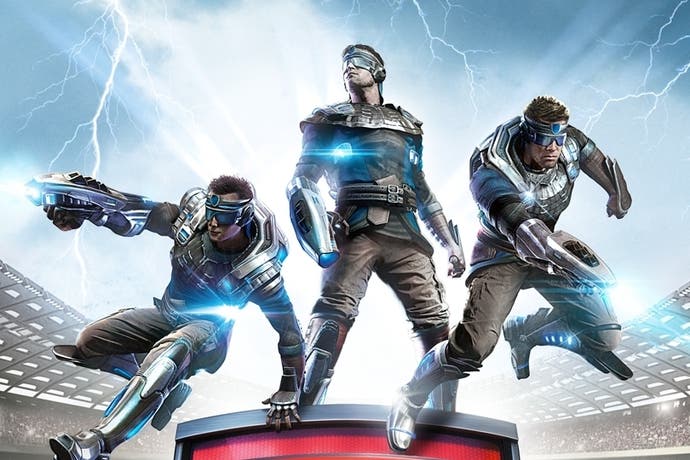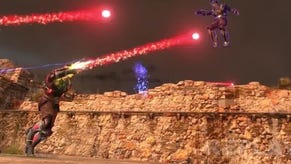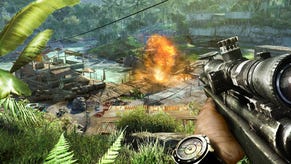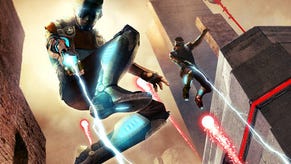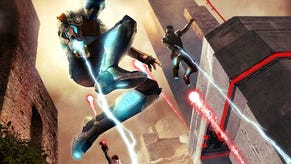ShootMania Storm review
Cannonical.
Reviewing Nadeo's multiplayer shooter ShootMania is an odd exercise; it is, in style if not in substance, rather like passing judgement on a box of paints. It is a matter of fact that some are red and some green, but what really matters is their eventual use. Do they sit in a drawer or become a constant companion - end up as a dilettante's plaything, or in the busy hands of a Picasso? The metaphor doesn't quite hold, of course, for one good reason; these days, everyone shares a canvas.
In ShootMania's case this means ManiaPlanet, a production that perhaps marks the ultimate expression of Nadeo's player-centric philosophy. Ever since its breakout success with the stunt racer TrackMania the developer has focused, with no small degree of altruism, on feeding its dedicated community with more tools, more options, more avenues for sharing. ManiaPlanet is a wonderful endpoint to this vision, a shared hub for Nadeo's games that has been knocking around in prototype builds for several months but seems now in a final form - until the next major update, naturally.
I can sum up why ManiaPlanet is a good thing very easily: it is not a pain in the ass. As you may imagine I have accounts on every gaming service going, and it never ceases to amaze that something like uPlay (from ShootMania's publisher Ubisoft) is such a lousy user experience; this is because it's been misconceived for a world where people play nothing but Ubisoft games. ManiaPlanet avoids such overestimation of its own importance and instead concentrates on fuss-free and fast start-up (yes!), clear navigation (YES) and providing easy access to downloads of community creations (YES I WILL YES). It's won a desktop shortcut on my PC, and that says everything.

ManiaPlanet is important not just because it's the front-end for ShootMania, but because it's the game's lifeblood. ShootMania comes with an extensive map editor, which I've been able to toy around with at length, and a set of tools for making objects and creating guns, which I haven't because they'll be released over the coming weeks. The editor's foundations will be familiar to TrackMania veterans, and its most important feature is simplicity - you can load this up with no prior knowledge or skills and make a passable shooter map in a few minutes.
Various tiles and landscape features are laid out at the bottom of the screen, and placing them is a matter of selecting, rotating, and clicking where you want it to go. More nuanced building is available in the advanced editor, which allows you to better shape an environment's contours and mess around with more fundamental aspects of the maps. Trying out your creation is a matter of a button press that zooms into a first-person view. Saving it is another button-press, and a short wait while certain visual data (absent from the builder for obvious reasons) is calculated. Sharing it is, yet again, another press. When even a chump like me can passably recreate Halo 2's Midship in an hour or so, the prospects for ShootMania's future are mouthwatering.
Creation is only one part of ShootMania's appeal, though in the long term it will undoubtedly produce the game's finest moments. At launch, the game features several Nadeo-created modes that give a glimpse into the toolset's possibilities, though they're of variable quality. The poorest is Joust, a one-on-one match-up with a 'winner stays on' format set in relatively simple arenas. Both players spawn at the same point but have to charge their wrist-mounted cannons at stations dotted symmetrically around the map's edges; so if they start running left you instinctively dash right, and then come back to meet each other in the middle.
Elite is shooter-as-sport par excellence, an exquisitely balanced and enormously fun mode unlike anything else in the genre

Joust is a good training ground for ShootMania, mostly because you spend so much time watching. Matches are won by the first player to seven hits, and each charge of the weapon gives five shots; as you can imagine, this leads to some comically drawn-out encounters. But even when it doesn't, and you're watching two decent players go at it, this still isn't what I want to do when playing a shooter - too much watching is a problem that rears its head a little in all of ShootMania's formats, but is at its most egregious in Joust.
The one thing Joust did teach me to do is move. Initially, ShootMania invites an unfavourable comparison to the wonderful Tribes Ascend because it shares a few principles: shots from the default cannon need to lead the target to hit, there's a frictionless speed burst and you can 'glide' after jumps. Basically I was trying to ski, but this game isn't about skiing. ShootMania's movement has a different take on momentum than it might seem initially, and the controls are incredibly precise - for example, jumping is a right-click, but the timing moves the action itself over a huge range from tiny staccato hops to bounding leaps. You can cover gigantic distances in seconds, and at almost any point turn on a sixpence and stop dead to plant a shot home.
You put such skills into practice with ShootMania's other two launch modes, Arena and Elite. Arena's a free-for-all with up to 16 players, set on large maps with a pole in the centre. Players spawn around the edges and converge; chaos ensues. After a short time the pole is available to capture, and the player who does so gains points and causes the map to start shrinking with a tornado effect. This part is faster than you might think, and forces every player to head for the middle for a final showdown.
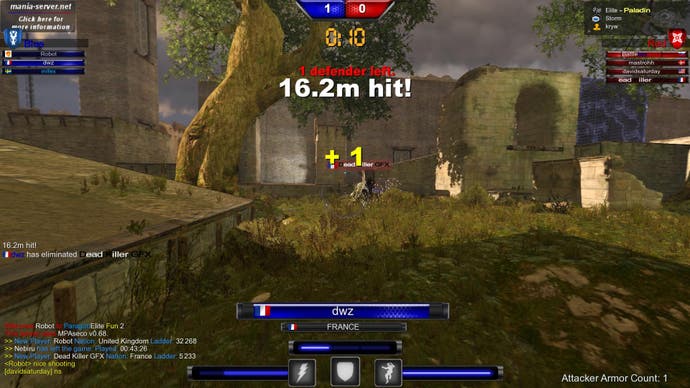
Arena showcases one particular aspect of ShootMania beautifully, and it's something that makes you realise how unimaginative most shooters are. There are only three guns in ShootMania, though of course there are endless player-created ones incoming, and each is only usable at certain points in Arena's maps - an exploding sticky ball gun in corridors, a focused ranged beam when on rails and next to windows, and the slow-moving but quick-firing cannon elsewhere.
Your reticle morphs to indicate the change as you move through the spaces, and each is of course perfect for its zone. It's such a videogame-y touch, built around utility in a virtual space rather than the real-world restriction of 'a gun's a gun', and each weapon's little kinks and specialities are soon hardwired into how you play. You'll pop off a few cannon shots, duck into a corridor and fire a bouncy ball backwards at pursuers, check out the window and snipe at a distant target, then move back out into the open blasting. When you get them right, the transitions are just awesome - and again, it's a feature that makes you as excited for ShootMania's future as its present.
What really delivers now, however, is Elite mode. Forget the needlessly intimidating name; this is shooter-as-sport par excellence, an exquisitely balanced and enormously fun mode unlike anything else in the genre. Two teams of three take turns on attack and defence. Each round, one player from the attacking team takes on three defenders; the attacker has a one-hit kill 'rifle' that strikes instantly but has a cooldown between shots, while the defenders have close-range cannons. The attacker wins by either eliminating all defenders or capturing a point. The point is only available for capture after some time has elapsed, but the cap time is very quick. The defenders win by hitting the attacker three times or if the round times out.
Judging by TrackMania, the fruits of the community's creativity will be seen both straight away and for a very long time to come
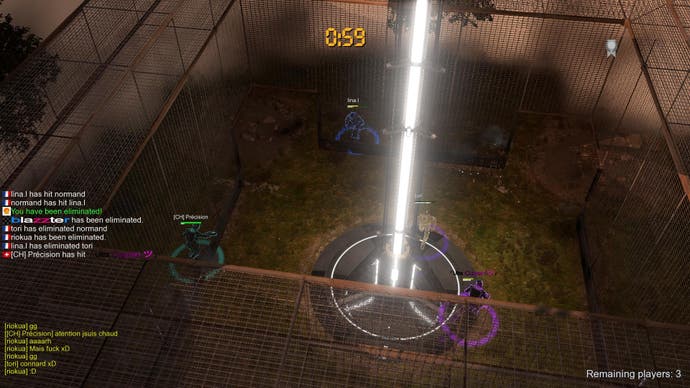
The maps for Elite tend to be long, built-up corridors full of cover and flanking opportunities, and these give the matches room for all sorts of rhythms; some rounds are over in seconds thanks to a deadeye attacker picking off a complacent defensive rush, or being overwhelmed by running into an ambush. Others become cat-and-mouse hunts around the architecture, with isolated defenders picked off one by one, or silence followed by a sudden mad dash for the capture. The loadouts for each side are beautifully balanced, with the attacker having a definite edge over any one defender but being easily outgunned when surrounded - and even when things look bleak, there's the ultimate get-out clause of the capture. This means rounds can look like an easy win for one side and suddenly switch entirely.
One thing might feel odd about Elite: your team-mates see what you see when you're the designated attacker. I'm a pretty good shooter player and still felt a little self-conscious at first. But everyone's in the same boat, and Elite inspires a level of camaraderie even among randoms that's simply much more mature than most other shooters. All I ever got and gave, even after terrible rounds, was encouragement and advice.
Sticking a score on ShootMania is an exercise in futility, because this is a toolbox as much as the modes it ships with. It is worth saying that, judging by TrackMania, the fruits of the community's creativity will be seen both straight away and for a very long time to come - and I don't think there could be a better studio in the world to have its hand on the tiller.
In terms of what you get at the time of writing: Elite is superb, Arena is pretty good, and Joust I probably won't play again. I'd say they're 10, 8 and 4 respectively. Shall I give it 7.3 recurring? Maybe I should rate the graphics too. Look, you get the point: who knows what's to come with ShootMania, because so much rests on the shoulders of players. But as Nadeo well knows, given the chance, we can create some pretty amazing things.
